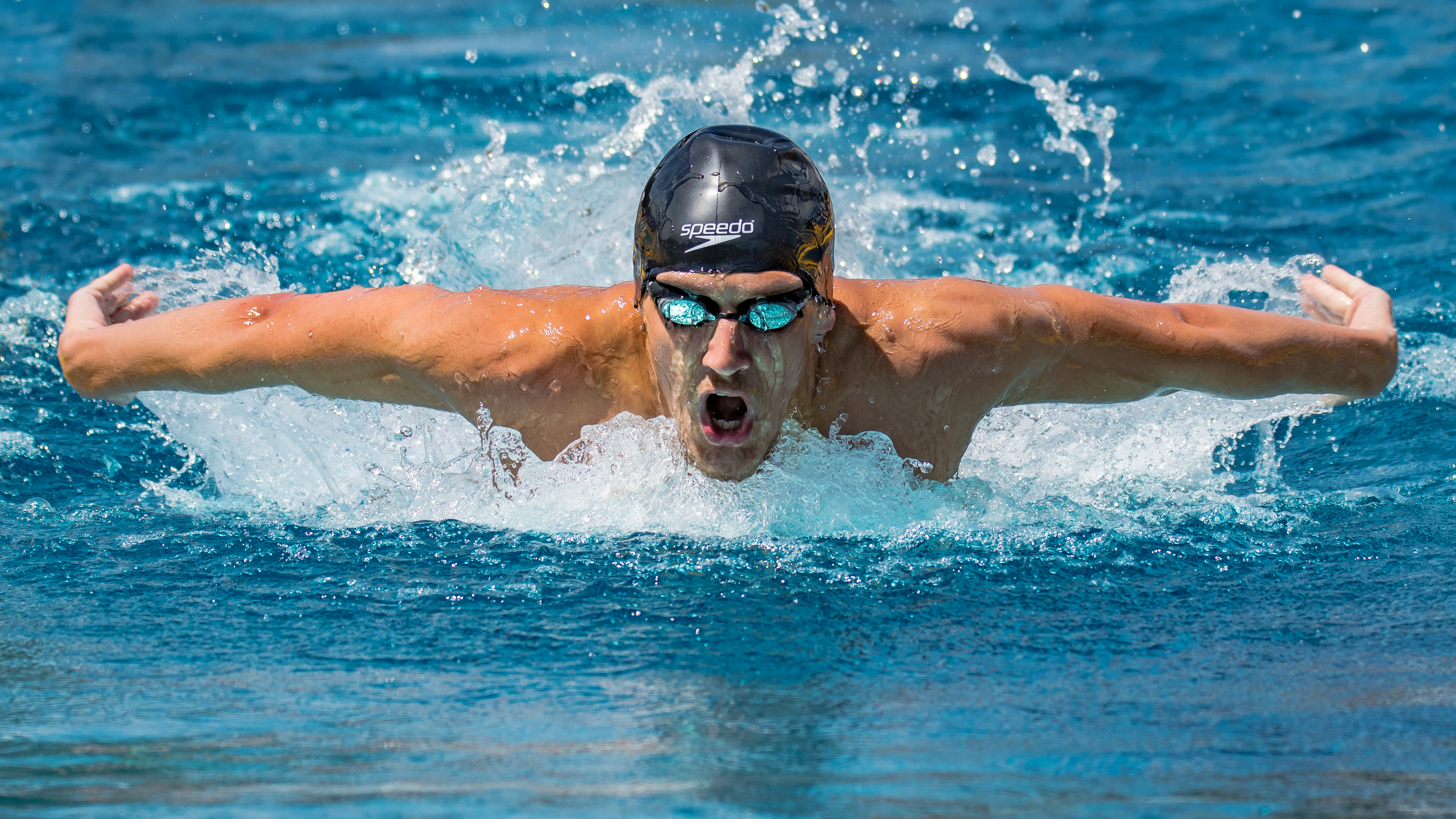|
Breaststroke
Breaststroke is a human swimming, swimming style in which the swimmer is on their chest and the torso does not rotate. It is the most popular recreational style due to the swimmer's head being out of the water a large portion of the time, and that it can be swum comfortably at slow speeds. In most swimming classes, beginners learn either the breaststroke or the freestyle (front crawl) first. However, at the competitive level, swimming breaststroke at speed requires endurance and strength comparable to other strokes. Some people refer to breaststroke as the "frog" stroke, as the arms and legs move somewhat like a frog swimming in the water. The stroke itself is the slowest of any competitive strokes and is thought to be the oldest of all swimming strokes. Speed and ergonomics Breaststroke is the slowest of the four official styles in swimming (sport), competitive swimming. The fastest breaststrokers can swim about 1.70 meters (~5.6 feet) per second. It is sometimes the harde ... [...More Info...] [...Related Items...] OR: [Wikipedia] [Google] [Baidu] |
Swimming (sport)
Swimming is an individual or team Racing, racing sport that requires the use of one's entire body to move through water. The sport takes place in Swimming pool, pools or open water (e.g., in a sea or lake). Competitive swimming is one of the most popular Olympic sports, with varied distance events in Butterfly stroke, butterfly, backstroke, breaststroke, Freestyle swimming, freestyle, and individual medley. In addition to these individual events, four swimmers can take part in either a freestyle or medley Relay race, relay. A medley relay consists of four swimmers who will each swim a different stroke, ordered as backstroke, breaststroke, butterfly and freestyle. Swimming each stroke requires a set of specific techniques; in competition, there are distinct regulations concerning the acceptable form for each individual stroke. There are also regulations on what types of swimsuits, caps, jewelry and injury tape that are allowed at competitions. There are many health benefits to ... [...More Info...] [...Related Items...] OR: [Wikipedia] [Google] [Baidu] |
Dolphin Kick
The dolphin kick is a kicking movement used in swimming. It is frequently used by competitive swimmers during entry and turns, and as part of the butterfly stroke. Description The dolphin kick is named for its resemblance to the motions made by a swimming dolphin. It is typically used in Swimming (sport), competitive swimming immediately after a swimmer enters the water or after turns. The swimmer performs the kick by moving both legs together, vertically, which sends a wave through the swimmer's body, propelling them forward. The stroke is useful in competitive swimming for its physical properties: it reduces Drag (physics), drag while providing a significant amount of thrust, with comparatively low physical exertion. In competitive breaststroke swimming, a single dolphin kick is allowed before the breaststroke pullout at the start and each turn, and it must be performed before the first breaststroke kick. This kick should occur after the swimmer leaves the wall and before the ... [...More Info...] [...Related Items...] OR: [Wikipedia] [Google] [Baidu] |
Butterfly Stroke
The butterfly (shortened to fly) is a List of swimming styles, swimming stroke swum on the chest, with both arms moving symmetrically, accompanied by the butterfly kick (also known as the "dolphin kick") along with the movement of the hips and chest. It is the newest swimming (sport), swimming style swum in competition, first swum in the early 1930s and originating out of the breaststroke. Speed and ergonomics The butterfly stroke boasts a higher peak velocity than the front crawl, owing to the synchronous propulsion generated by the simultaneous pull/push of both arms and legs. However, due to the pronounced drop in speed during the recovery phase, it is marginally slower than the front crawl, especially over extended distances. Furthermore, the butterfly stroke demands a different level of physical exertion, contributing to its slower overall pace than the front crawl. Butterfly stroke without text.gif Butterfly stroke3 without text.gif History of the butterfly stroke ... [...More Info...] [...Related Items...] OR: [Wikipedia] [Google] [Baidu] |
Human Swimming
Swimming is the self-propulsion of a person through water, such as saltwater or freshwater environments, usually for recreation, sport, exercise, or survival. Swimmers achieve locomotion by coordinating limb and body movements to achieve hydrodynamic thrust that results in directional motion. Newborns can instinctively hold their breath underwater and exhibit rudimentary swimming movements as part of a survival reflex. Swimming requires endurance, skill and efficient techniques to maximize speed and minimize energy consumption. Swimming is a popular activity and competitive sport where certain techniques are deployed to move through water. It offers numerous health benefits, such as strengthened cardiovascular health, muscle strength, and increased flexibility. It is suitable for people of all ages and fitness levels. Swimming is consistently among the top public recreational activities, and in some countries, swimming lessons are a compulsory part of the educational curriculum ... [...More Info...] [...Related Items...] OR: [Wikipedia] [Google] [Baidu] |
Masaru Furukawa
was a Japanese swimmer and Olympic champion. He competed at the 1956 Olympic Games in Melbourne, where he received a gold medal in the 200 m breaststroke."1956 Olympics – Melbourne, Australia – Swimming" – ''databaseOlympics.com'' (Retrieved on September 5, 2008) World records Furukawa improved the world record of 200 metres breaststroke (long course) four times in 1954 and 1955, and his last record lasted until 1958.Awards Furukawa was inducted into the |
Butterfly (swimming)
The butterfly (shortened to fly) is a swimming stroke swum on the chest, with both arms moving symmetrically, accompanied by the butterfly kick (also known as the "dolphin kick") along with the movement of the hips and chest. It is the newest swimming style swum in competition, first swum in the early 1930s and originating out of the breaststroke. Speed and ergonomics The butterfly stroke boasts a higher peak velocity than the front crawl, owing to the synchronous propulsion generated by the simultaneous pull/push of both arms and legs. However, due to the pronounced drop in speed during the recovery phase, it is marginally slower than the front crawl, especially over extended distances. Furthermore, the butterfly stroke demands a different level of physical exertion, contributing to its slower overall pace than the front crawl. Butterfly stroke without text.gif Butterfly stroke3 without text.gif History of the butterfly stroke Origins of the butterfly kick The earl ... [...More Info...] [...Related Items...] OR: [Wikipedia] [Google] [Baidu] |
Streamline (swimming)
Streamline form is a swimming technique that is used underwater in every stroke. At the start Start can refer to multiple topics: * Takeoff, the phase of flight where an aircraft transitions from moving along the ground to flying through the air * Starting lineup in sports * Track and field#Starts use in race, Starts use in sport race * S ... of a race or on a turn, streamline form is used, usually along with a dolphin kick or flutter kick, to create the least amount of resistance to help the swimmer propel as far as they can. Many factors contribute to the perfect streamline form and mastering this method increases a swimmer's speed. Streamline is one of the key fundamentals to mastering any stroke. Technique The streamline position consists of a person placing hand over hand, fingers over fingers and raising their arms above their head so the biceps are tucked close to the ears. The belly is sucked back to decrease curvature of the spine in the lower back and the swimmer's he ... [...More Info...] [...Related Items...] OR: [Wikipedia] [Google] [Baidu] |
David Armbruster (swim Coach)
Jack George Sieg (December 10, 1914 – December 21, 1968) was an American swimmer who used the butterfly stroke in 1935, developed by his coach Dave Armbruster. He competed for the University of Iowa and first used the stroke in a breaststroke leg of a medley relay February 25, 1935. February 26, 1935: “for the first time in competition Monday” ( The Milwaukee Journal
The ''Milwaukee Journal Sentinel'' is a daily morning broadsheet printed in Milwaukee, Wisconsin, where it is the primary newspaper and also the largest newspaper in the state of Wisconsin, where it is widely read. It wa ...
[...More Info...] [...Related Items...] OR: [Wikipedia] [Google] [Baidu] |
University Of Iowa
The University of Iowa (U of I, UIowa, or Iowa) is a public university, public research university in Iowa City, Iowa, United States. Founded in 1847, it is the oldest and largest university in the state. The University of Iowa is organized into 12 colleges offering more than 200 areas of study and 7 professional degrees. On an urban 1,880-acre campus on the banks of the Iowa River, the University of Iowa is Carnegie Classification of Institutions of Higher Education, classified among "R1: Doctoral Universities – Very high research activity". In fiscal year 2021, research expenditures at Iowa totaled $818 million. The university was the original developer of the Master of Fine Arts degree, and it operates the Iowa Writers' Workshop, whose alumni include 17 of the university's 46 Pulitzer Prize winners. Iowa is a member of the Association of American Universities and the Universities Research Association. Among public universities in the United States, UI was the first to beco ... [...More Info...] [...Related Items...] OR: [Wikipedia] [Google] [Baidu] |
Jack Sieg
Jack George Sieg (December 10, 1914 – December 21, 1968) was an American swimmer who used the butterfly stroke in 1935, developed by his coach Dave Armbruster. He competed for the University of Iowa The University of Iowa (U of I, UIowa, or Iowa) is a public university, public research university in Iowa City, Iowa, United States. Founded in 1847, it is the oldest and largest university in the state. The University of Iowa is organized int ... and first used the stroke in a breaststroke leg of a medley relay February 25, 1935. February 26, 1935: “for the first time in competition Monday” ( The Milwaukee Journal). See also ...
|
Phelps 400m IM Missouri GP 2008 Retouched
Phelps may refer to: Places in the United States * Phelps, Kentucky * Phelps, Michigan, an unincorporated community * Phelps, New York ** Phelps (village), New York * Phelps, Wisconsin, a town ** Phelps (community), Wisconsin, an unincorporated community * Phelps County, Missouri * Phelps County, Nebraska * Phelps Lake (other) * Lake Phelps Other uses * Phelps (surname) * Phelps Phelps, 38th Governor of American Samoa and United States Ambassador to the Dominican Republic * USS ''Phelps'' (DD-360), a US Navy destroyer See also * * Philps Philps is a surname. Notable people with the surname include: * Andrew Philps (1857–1929), Canadian politician * Walter Philps (1903–?), English cricketer See also * Philp * Phipps (surname) {{Short pages monitor [Baidu] |
1936 Summer Olympics
The 1936 Summer Olympics (), officially the Games of the XI Olympiad () and officially branded as Berlin 1936, were an international multi-sport event held from 1 to 16 August 1936 in Berlin, then capital of Nazi Germany. Berlin won the bid to host the Games over Barcelona on the 29th IOC Session on 26 April 1931. The 1936 Games marked the second and most recent time the International Olympic Committee gathered to vote in a city bidding to host those Games. Later rule modifications forbade cities hosting the bid vote from being awarded the games. To outdo the 1932 Summer Olympics, 1932 Los Angeles Games, Adolf Hitler had Olympiastadion (Berlin), a new 100,000-seat track and field stadium built, as well as six gymnasiums and other smaller arenas. The Games were the first to be Fernsehsender Paul Nipkow, televised, with radio broadcasts reaching 41 countries.Rader, Benjamin G. "American Sports: From the Age of Folk Games to the Age of Televised Sports", 5th ed. Filmmaker Leni Ri ... [...More Info...] [...Related Items...] OR: [Wikipedia] [Google] [Baidu] |







